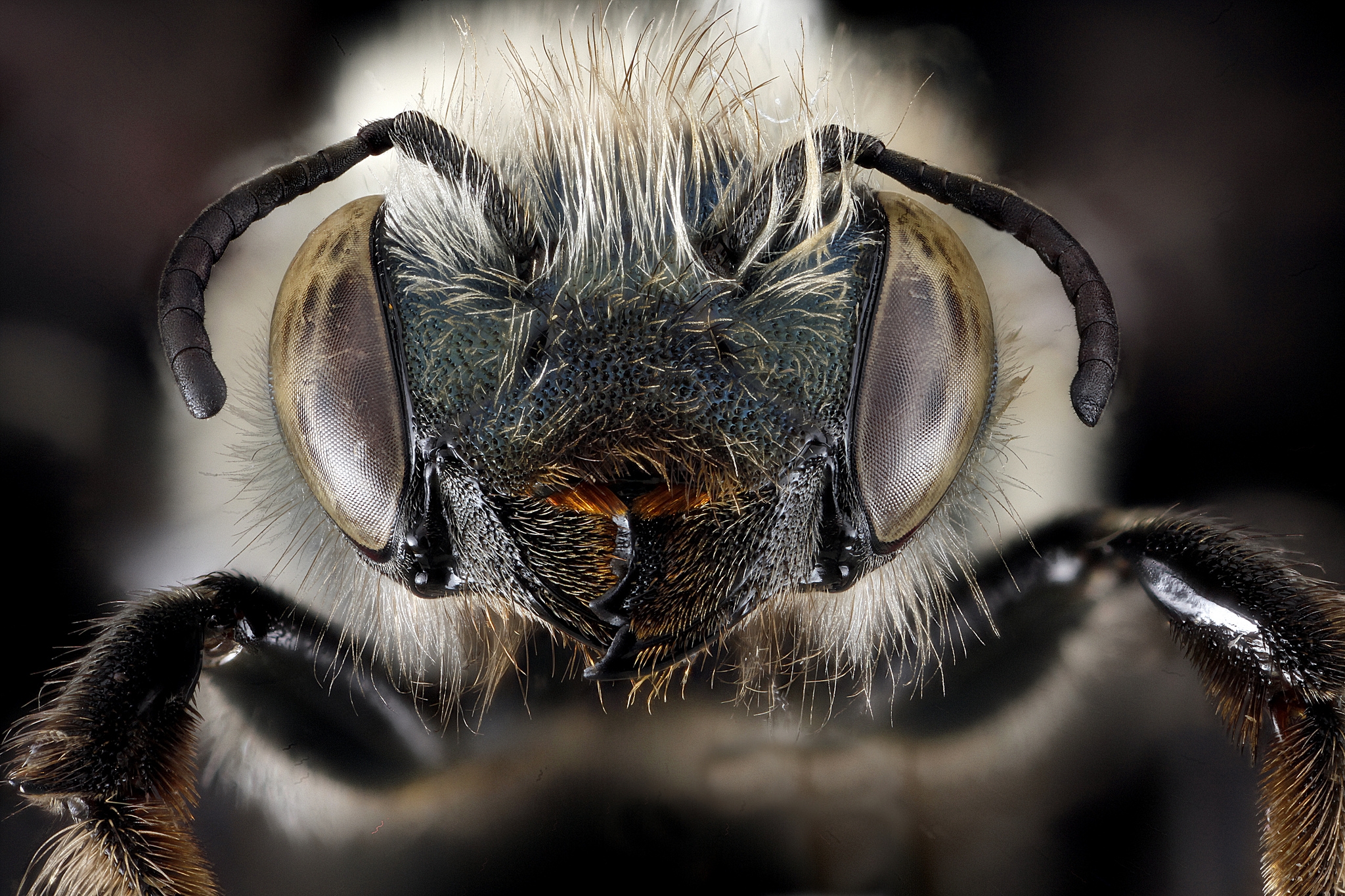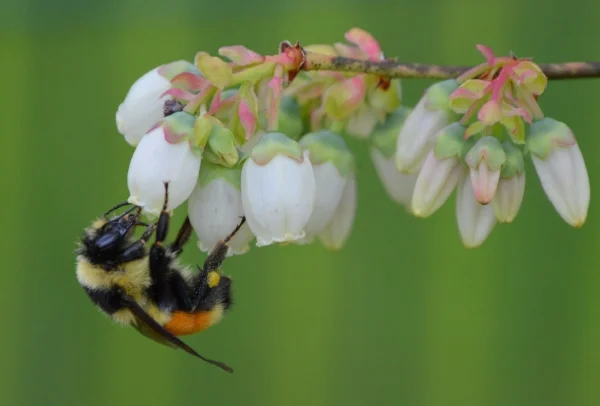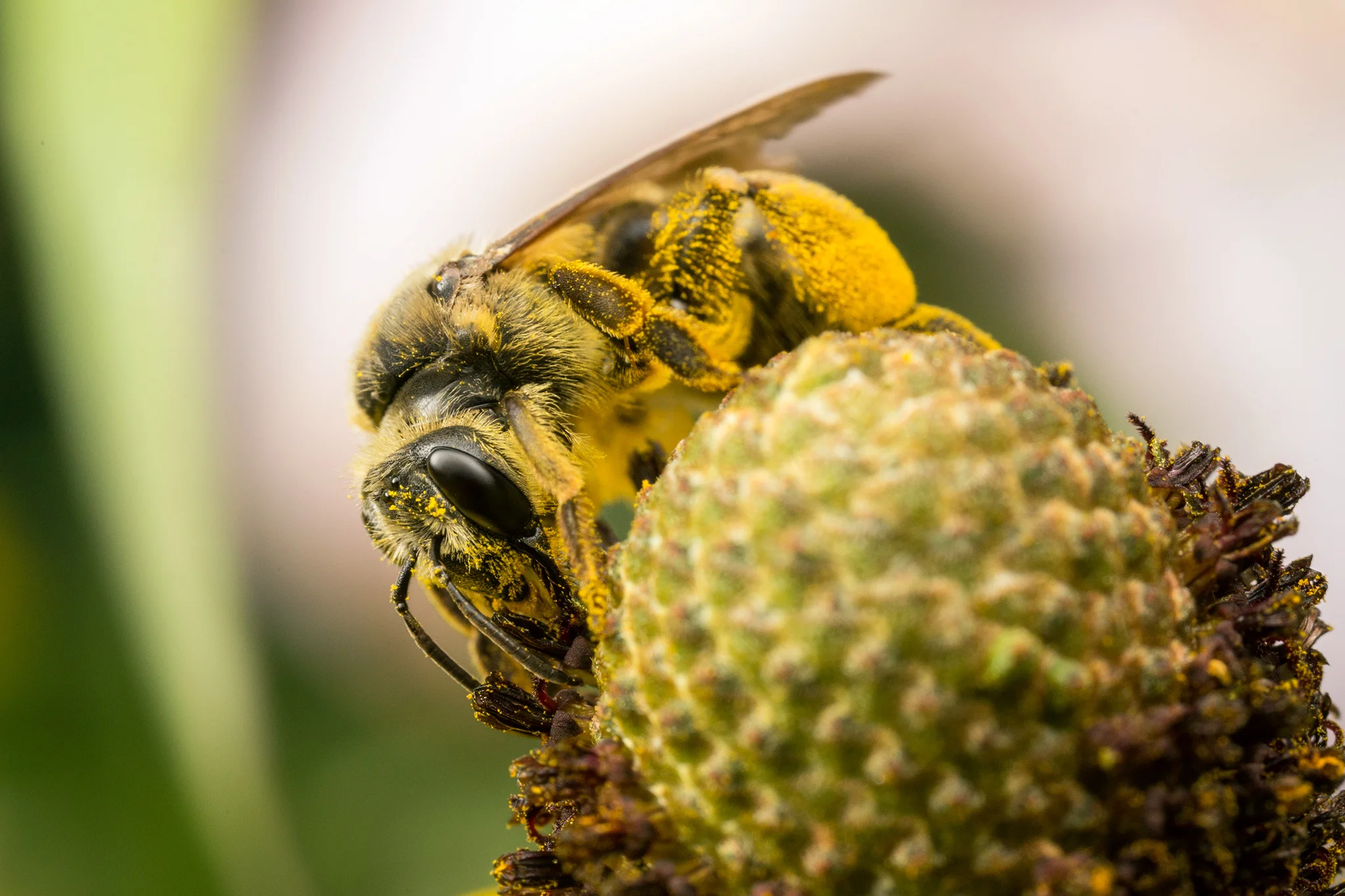Metallic green sweat bee (Agapostemon texanus) on coneflower (Echinacea spp.). Photo: Kathy Keatley Garvey.
“We have over 4,000 species of native bees in North America that have co-evolved with our native plants over millions of years. ”
In the summer of 2016 I attended what I called "bee camp" at Eagle Hill Institute in Downeast Maine. The actual name of the week-long intensive seminar was "Native Bees as Pollinators", but it was more fun to proclaim to friends and family that I would be attending "bee camp", and so I did. If you haven't been to Eagle Hill, I highly recommend checking it out. The Institute is "best known for the advanced natural history science seminars and scientific illustration workshops". The campus is beautiful, the food outstanding, and the atmosphere is nothing short of magical. If you are a nature enthusiast, taking one of their seminars feels like sleepaway camp for grown-ups. It's a place where you can totally geek-out, eat good food, make new friends, and take a deep dive into a natural history subject.
At the time I attended the seminar, I had already been developing pollinator enhancement plans for landowners, but I wanted to go deeper and understand the biology and ecology of native bees in more detail. I had no idea how hooked I would become on these continually captivating animals.
The seminar was taught by three knowledgeable and passionate scientists: Dr. Frank Drummond, Dr. Alison Dibble, and Dr. Sara Bushmann. There were lively lectures, field collection excursions on our beautiful coastline, and late nights looking through a microscope trying to key out pinned specimens (entomologists must collect and pin insects in order to adequately study them, and is a widely accepted practice).
It was in those late hours looking through the microscope that I fell in love with native bees. Scroll on dear, reader, and you will see why.
A mason bee (Osmia simillima), collected in Acadia National Park, Maine. Bees in the genus Osmia are one our most economically significant native bees because of their pollinator services to orchards and other crops. See more of the USGS Bee Inventory and Monitoring Lab's images here.
What is a "Native" or "Wild" Bee?
As you probably know, pollinators are in significant decline due to a combination of factors including loss of habitat, disease, parasites, and environmental contaminants. However, honey bees have received most of the attention. Our domesticated honey bees pollinate many of our crops and provide valuable honey, but they are not native here. They were brought over from Europe about four hundred years ago and their numbers are vast (almost 3 million hives in the U.S. alone).
We have over 4,000 species of native bees in North America that have co-evolved with our native plants over millions of years, many of which are experiencing catastrophic declines. For example, in 2017 the rusty patched bumble bee (Bombus affinis) was listed as federally endangered under the Endangered Species Act. This bee represented over 20% of Maine bumble bees 20-30 years ago, but it hasn't been seen in the State since 2009.
In Maine alone we have at least 270 species of native, or wild bees, most of which are solitary bees, meaning they don't live in a social community like honey bees or bumble bees do.
Tri-colored/orange-belted bumble bee (Bombus ternarius) on blueberry blossoms. This species is one of 17 bumble bee species we have in Maine. Photo: Sheila Wakefield of Sheila's Maine.
Wild Bees are Super-pollinators
Native bees are North America’s most important group of pollinators and play a vitally important role in maintaining the structure of many types of natural communities. As ‘keystone species’ bees play a critical role in upholding the integrity, productivity and sustainability of a forest understory, pasture, field, meadow, farm, orchard, or backyard garden. Bees pollinate flowering plants as they forage for food—without them many plants would become extinct. In addition to being key to plant reproduction, pollinators also form the basis of an energy-rich food web.
Many native bees are veritable “super-pollinators”. Based on experimental evidence, the Maine blueberry bee (Osmia atriventris) is at least 7 times more efficient than the honey bee at pollinating lowbush blueberry. Solitary native bees, like the Osmia or the Andrena (below) gather dry, loose pollen from head to toe on their very hairy bodies.
Pollen-covered mining bee (Andrena spp.) on coneflower. Photo: Alex Wild, Insects Unlocked.
Wild Bees are Gentle & Docile
It's amazing I work with bees, considering my dear departed mother was deeply fearful of them. Throughout my childhood I have memories of her shrieking and being altogether terror-stricken if a "bee" was in our vicinity. One crystal clear memory I have of her fleeing a "bee" is when she was sunbathing in a chaise lounge beside a crowded public pool. My young brother and I were shocked to hear our mother scream at the top of her lungs as she sprung up out of her lounger, and jumped into the pool like a woman gone mad, fully attired in her designer sunglasses and a flowy shift dress. Her visceral fear was understandable because she was allergic. Looking back, I realize now that in most cases she was reacting to wasps, yellow jackets, or hornets.
So many people mistakenly identify many things for "bees". I can't tell you how many backyard barbeques I've been at where I've tackled this misconception, usually without much success in persuading my listener that "those aren't bees circling the lemonade".
Bees get a bad rap due to misidentification, horror stories of Africanized honey bees (the result of a science experiment gone wrong), and overall generalizations.
Native bees are gentile and docile, rarely sting, and their venom is mild (i.e. it will not cause anaphylactic shock).
Maybe this knowledge, or simply the fascinating lives of our native bees, will encourage you to take up a hobby I like to call "Zen and the Art of Bee Observation".
Get out in your garden, find a patch of flowers and patiently wait for the bees to reveal themselves. Chances are you'll observe a bee you never noticed before. Watch and learn. Observe the pollen-coated hairy body of a mining or mason bee, or the loaded pollen basket of a bumble bee. Show the children in your life the magic work of these brilliantly busy and complex creatures. Sit in gratitude for their work in the world, as we have pollinators to thank for peaches and apples, chocolate and strawberries, spices, medicines, and so much more.
Pollinator Presentations
I present numerous talks, classes, and/or workshops on pollinators throughout Maine. Please see my events page for a full and frequently-updated listing, and please reach out if you or your group would like to host me!
Recommended Reading
Our Native Bees by Paige Embry
“Embry’s book is witty, insightful, and full of valuable information for both the long-time lover of bees and those just-now curious. She captures the essence of a bee’s natural history and how we use (and sometimes abuse) bees.” — Olivia Messinger Carril, author of The Bees in Your Backyard: A Guide to North America’s Bees
Pollinators of Native Plants by Heather Holm
"If you are a person that lingers at flowers and gets close enough to marvel at all the bees, butterflies, moths, beetles, wasps, and flies that visit flowers for food, you will love this book. Heather Holm has compiled a gorgeous and super-informative guide to the pollinating insects that visit native prairie, woodland and wetland flowering plants. At last, a book that tells us the whole picture: the bloom time, range, habitat, and characteristics of flowers that attract pollinators, and the life-histories and fascinating traits of the many beneficial insects that pollinate the flowers. As I sit here on this cold winter day admiring the beautiful photos, I am filled with hope that our bees and pollinators will abound next summer and evermore."
— Marla Spivak, Professor, University of Minnesota
Bees: An Identification and Native Plant Forage Guide by Heather Holm
"It would be hard to imagine a book more chock-full of the information we need to save our native bees. From helpful ID tips, to body size ranges, to seasonal distribution, to 99 species of the trees, shrubs, and perennials preferred by 27 genera of our most common bees, Heather Holm covers it all. This is the book pollination biologists and homeowners alike have been waiting for!" —Douglas Tallamy, author of Bringing Nature Home
Attracting Native Pollinators by The Xerces Society
"Here is the most comprehensive treatment yet of native pollinators, detailing natural history, ecological importance, taxonomy, conservation, and restoration of native pollinator communities. Attracting Native Pollinators belongs on the bookshelf to everyone who values the future of the natural world." — Douglas W. Tallamy, author, Bringing Nature Home
The Bees in Your Backyard by Joseph S. Wilson & Olivia Messinger Carril
"The decline of bees in recent years has led to a growing awareness of the importance of these insects. The Bees in Your Backyard provides a great introduction to the bees of North America and an invaluable aid to anyone learning to differentiate the various kinds. I know of no other book for general readers that describes all the genera to this extent." — Sheila Colla, coauthor of Bumble Bees of North America: An Identification Guide
Did you know? Maine blueberry growers bring in 80,000 honeybees to pollinate blueberry crops each year. I work with blueberry growers to boost native bee populations that pollinate more efficiently.
Scientists estimate that one out of every three mouthfuls of the food and drink we consume is brought to us by pollinators.
SIGN UP TO RECEIVE FREE HABITAT TIPS, TOOLS, AND TRICKS AND ADVANCE NOTICE OF DEB’S SIGNATURE EVENTS.
#ThePersonalEcologist
I co-create biodiverse habitats with eco-minded stewards throughout the Northeast - at any scale.
I have 30 years of experience and a lifelong commitment to wildlife conservation.
Read My Story.
-
Deborah
Perkins
- Dec 22, 2023 Storm Habitat: Nurse Logs, Dens, and More
- Aug 8, 2023 Beautiful Buttonbush in Bloom
- Jun 17, 2023 Snapping Turtles on the Move
- Feb 1, 2023 The True Harbingers of Spring: Chickadees
- Mar 20, 2021 The Power of Photoperiod
- Feb 19, 2021 The Golden-crowned Kinglet: A Royally Charming Winter Resident
- Feb 8, 2021 Subnivean Secrets
- Jan 9, 2021 Wild Reads: Ravens in Winter
- Oct 23, 2020 Flower “Beds” for Bumble Bees
- Oct 4, 2020 Wise Oaks, Clever Jays
- Sep 11, 2020 Goldenrods: Top Plants for Boosting Biodiversity
- Aug 25, 2020 Gentle Golden Wasps Adorned with Pollen
- Aug 1, 2020 Water for Wildlife - Birdbath Basics & More
- Jul 19, 2020 Fruits of the Forest
- Jul 11, 2020 Hungry Little Hummingbirds
- Jun 24, 2020 Hatching Out: Mother Nature's "Escape Room"
- Jun 12, 2020 Maine's Real Lupine Revealed
- May 31, 2020 Wild Geranium in Flower
- May 24, 2020 Moosewood Chandeliers
- May 17, 2020 Shadbush in Bloom
- May 7, 2020 Native Nectar for Queen Bumble Bees
- Apr 25, 2020 Waves of Warblers
- Apr 19, 2020 Attracting Bluebirds without Boxes
- Apr 12, 2020 Hungry Bears on the Move
- Apr 5, 2020 Bees on Red Maple Flowers
- Mar 27, 2020 Sky Dancing
- Mar 22, 2020 Fox Kits Being Born
- Mar 15, 2020 Corvids a-Courtin’
- Mar 8, 2020 Phenology Notes: Witnessing The Seasons of our Wild World
- Feb 5, 2019 Plan Your Habitat Garden
- Jan 2, 2019 Wild Reads: We Took to The Woods
- Nov 28, 2018 Winterberry: The Gift that Keeps on Giving
- Aug 16, 2018 Where Have All the Whip-poor-wills Gone?
- Jun 22, 2018 Give a Warm Welcome to Wild Bees (Super-pollinators Part 2)
- May 16, 2018 The Wonder of Wild Bees (Super-pollinators Part 1)
- Apr 19, 2018 Saving Songbirds Starts with Your Morning Coffee
- Mar 21, 2018 Wildlife Habitat Design in A Wounded World
- Feb 16, 2018 “Intelligent Tinkering” - How to Boost Biodiversity at Home (Leopold’s Wise Words Part 2)
- Jan 18, 2018 Carnivore Coexistence (Leopold's Wise Words - Part 1)
- Dec 14, 2017 Dead and Dying Trees are Key to Life
- Nov 14, 2017 A Top Threat to Biodiversity: Invasive Plants
- Oct 18, 2017 Hallowed Habitat
- Sep 21, 2017 Beechnuts - Superfood for Bears & Other Wildlife
- Aug 22, 2017 Baby Bats Need Love Too
- Jul 25, 2017 Bring the Magic of Fireflies Back Home Again






